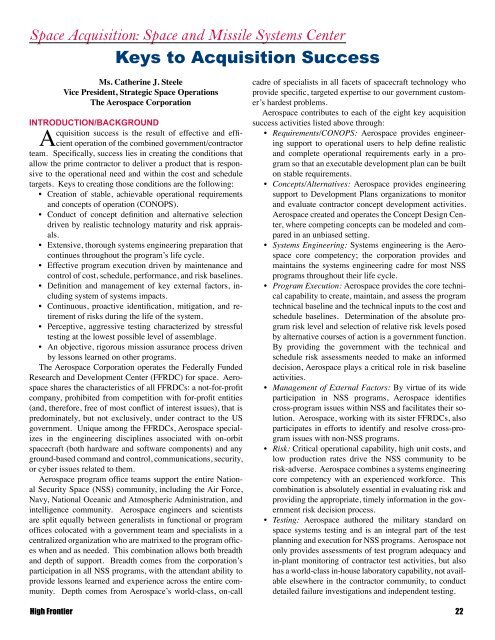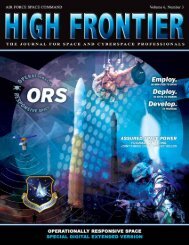Space Acquisition - Air Force Space Command
Space Acquisition - Air Force Space Command
Space Acquisition - Air Force Space Command
Create successful ePaper yourself
Turn your PDF publications into a flip-book with our unique Google optimized e-Paper software.
<strong>Space</strong> <strong>Acquisition</strong>: <strong>Space</strong> and Missile Systems Center<br />
Keys to <strong>Acquisition</strong> Success<br />
Ms. Catherine J. Steele<br />
Vice President, Strategic <strong>Space</strong> Operations<br />
The Aerospace Corporation<br />
INTRODUCTION/BACKGROUND<br />
<strong>Acquisition</strong> success is the result of effective and efficient<br />
operation of the combined government/contractor<br />
team. Specifically, success lies in creating the conditions that<br />
allow the prime contractor to deliver a product that is responsive<br />
to the operational need and within the cost and schedule<br />
targets. Keys to creating those conditions are the following:<br />
• Creation of stable, achievable operational requirements<br />
and concepts of operation (CONOPS).<br />
• Conduct of concept definition and alternative selection<br />
driven by realistic technology maturity and risk appraisals.<br />
• Extensive, thorough systems engineering preparation that<br />
continues throughout the program’s life cycle.<br />
• Effective program execution driven by maintenance and<br />
control of cost, schedule, performance, and risk baselines.<br />
• Definition and management of key external factors, including<br />
system of systems impacts.<br />
• Continuous, proactive identification, mitigation, and retirement<br />
of risks during the life of the system.<br />
• Perceptive, aggressive testing characterized by stressful<br />
testing at the lowest possible level of assemblage.<br />
• An objective, rigorous mission assurance process driven<br />
by lessons learned on other programs.<br />
The Aerospace Corporation operates the Federally Funded<br />
Research and Development Center (FFRDC) for space. Aerospace<br />
shares the characteristics of all FFRDCs: a not-for-profit<br />
company, prohibited from competition with for-profit entities<br />
(and, therefore, free of most conflict of interest issues), that is<br />
predominately, but not exclusively, under contract to the US<br />
government. Unique among the FFRDCs, Aerospace specializes<br />
in the engineering disciplines associated with on-orbit<br />
spacecraft (both hardware and software components) and any<br />
ground-based command and control, communications, security,<br />
or cyber issues related to them.<br />
Aerospace program office teams support the entire National<br />
Security <strong>Space</strong> (NSS) community, including the <strong>Air</strong> <strong>Force</strong>,<br />
Navy, National Oceanic and Atmospheric Administration, and<br />
intelligence community. Aerospace engineers and scientists<br />
are split equally between generalists in functional or program<br />
offices colocated with a government team and specialists in a<br />
centralized organization who are matrixed to the program offices<br />
when and as needed. This combination allows both breadth<br />
and depth of support. Breadth comes from the corporation’s<br />
participation in all NSS programs, with the attendant ability to<br />
provide lessons learned and experience across the entire community.<br />
Depth comes from Aerospace’s world-class, on-call<br />
cadre of specialists in all facets of spacecraft technology who<br />
provide specific, targeted expertise to our government customer’s<br />
hardest problems.<br />
Aerospace contributes to each of the eight key acquisition<br />
success activities listed above through:<br />
• Requirements/CONOPS: Aerospace provides engineering<br />
support to operational users to help define realistic<br />
and complete operational requirements early in a program<br />
so that an executable development plan can be built<br />
on stable requirements.<br />
• Concepts/Alternatives: Aerospace provides engineering<br />
support to Development Plans organizations to monitor<br />
and evaluate contractor concept development activities.<br />
Aerospace created and operates the Concept Design Center,<br />
where competing concepts can be modeled and compared<br />
in an unbiased setting.<br />
• Systems Engineering: Systems engineering is the Aerospace<br />
core competency; the corporation provides and<br />
maintains the systems engineering cadre for most NSS<br />
programs throughout their life cycle.<br />
• Program Execution: Aerospace provides the core technical<br />
capability to create, maintain, and assess the program<br />
technical baseline and the technical inputs to the cost and<br />
schedule baselines. Determination of the absolute program<br />
risk level and selection of relative risk levels posed<br />
by alternative courses of action is a government function.<br />
By providing the government with the technical and<br />
schedule risk assessments needed to make an informed<br />
decision, Aerospace plays a critical role in risk baseline<br />
activities.<br />
• Management of External Factors: By virtue of its wide<br />
participation in NSS programs, Aerospace identifies<br />
cross-program issues within NSS and facilitates their solution.<br />
Aerospace, working with its sister FFRDCs, also<br />
participates in efforts to identify and resolve cross-program<br />
issues with non-NSS programs.<br />
• Risk: Critical operational capability, high unit costs, and<br />
low production rates drive the NSS community to be<br />
risk-adverse. Aerospace combines a systems engineering<br />
core competency with an experienced workforce. This<br />
combination is absolutely essential in evaluating risk and<br />
providing the appropriate, timely information in the government<br />
risk decision process.<br />
• Testing: Aerospace authored the military standard on<br />
space systems testing and is an integral part of the test<br />
planning and execution for NSS programs. Aerospace not<br />
only provides assessments of test program adequacy and<br />
in-plant monitoring of contractor test activities, but also<br />
has a world-class in-house laboratory capability, not available<br />
elsewhere in the contractor community, to conduct<br />
detailed failure investigations and independent testing.<br />
High Frontier 22











